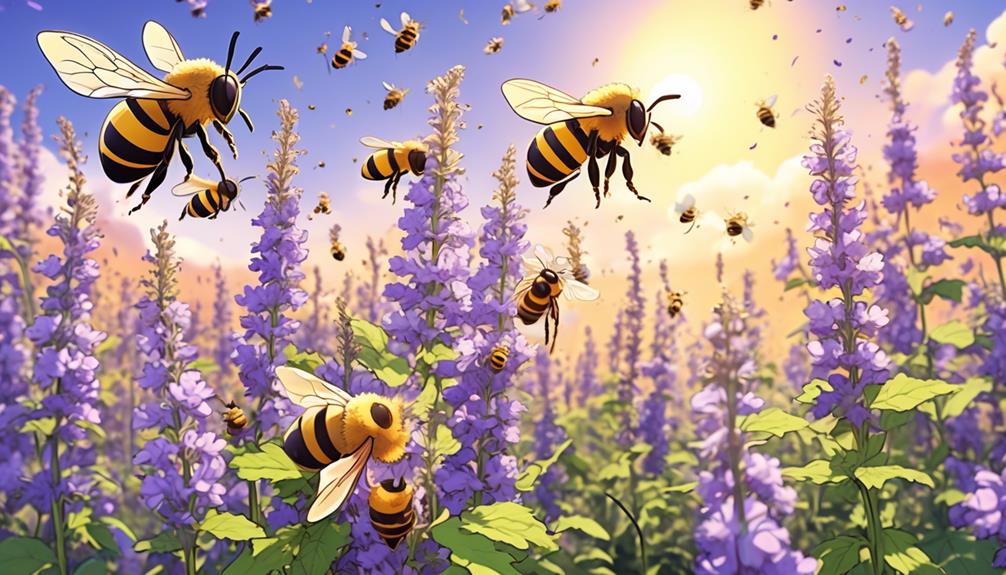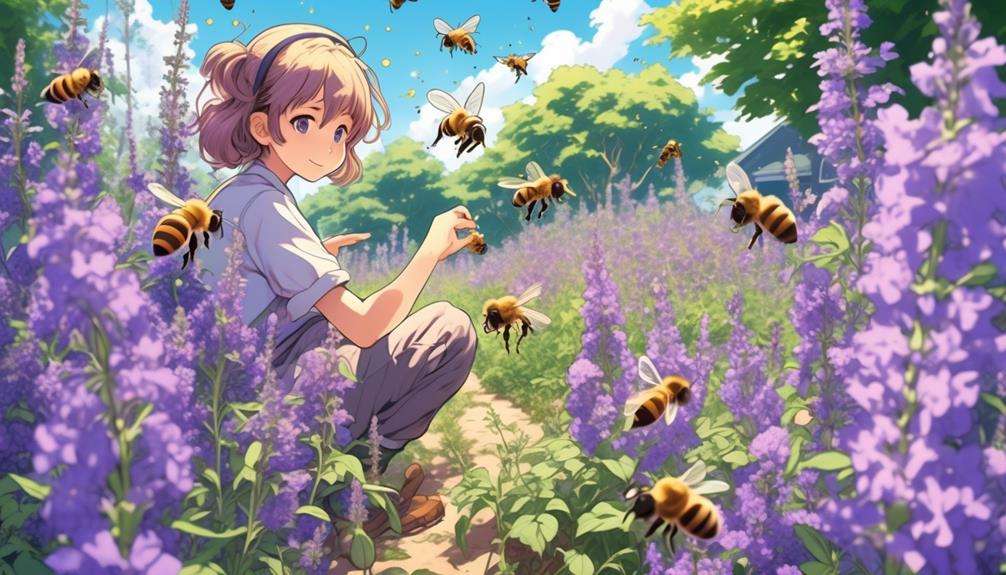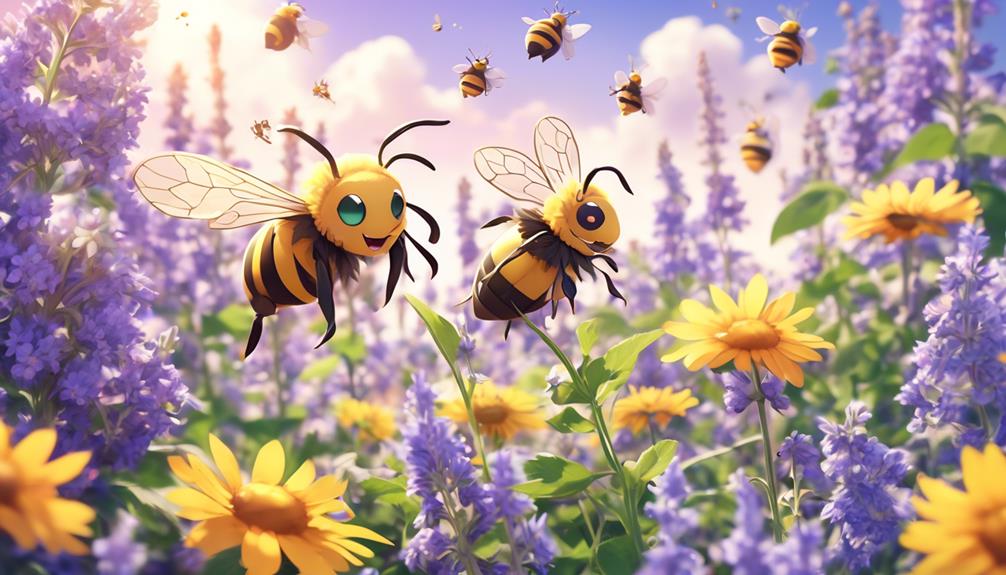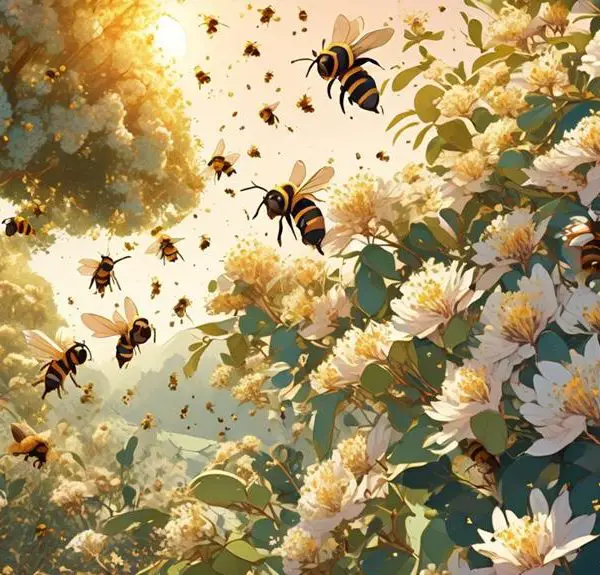Discover why bees are irresistibly drawn to catmint and unravel the mystery behind this fascinating garden interaction.

Do Bees Like Catmint?
Bumbling bees buzzing around blossoming flowers is a common sight, isn't it?
Now, consider your garden, speckled with the attractive allure of catmint. You've probably noticed a significant number of these winged visitors hovering over this particular plant.
But why is that? Why do bees seem to have a special affinity for catmint?
While you might be quick to attribute it to the plant's vibrant violet hues, there's more to this symbiotic relationship than meets the eye.
Stick around, and let's unravel this intriguing interaction together.
Key Takeaways
- Catmint, scientifically known as Nepeta cataria, is a perennial plant with aromatic foliage and lavender-blue flowers.
- Bees are attracted to catmint due to its high nectar production, rich pollen, vibrant colors, and strong fragrance.
- The symbiosis between bees and catmint involves bees inadvertently transferring pollen while foraging, promoting genetic diversity and plant survival.
- Catmint provides a reliable source of nectar for bees, with energy-dense sugar content, easily visible blue-violet flowers, and resistance to pests and diseases.
Understanding Catmint: A Brief Overview

Diving into the world of catmint, you'll find that this perennial plant, scientifically known as Nepeta cataria, is renowned for its aromatic foliage and lavender-blue flowers, making it a favorite amongst bees. Belonging to the mint family, Lamiaceae, catmint is native to Europe, Asia, and Africa. It's hardy, drought-tolerant, and thrives in full sun to partial shade, adaptable to a wide range of soil types.
Analyzing its structure, you'll observe that catmint grows in a mounding habit, reaching heights of 2-3 feet, with grey-green leaves that have a heart-shaped base. Notably, it's the plant's phenolic compounds, particularly nepetalactone, that are responsible for its strong scent. This compound isn't only attractive to cats but also to pollinators, like bees.
In terms of propagation, catmint is easily grown by seed, division, or cuttings. It's also resistant to most pests and diseases, contributing to its low-maintenance appeal. You'll notice that catmint's flowering period extends from late spring to early fall, providing a long-lasting nectar source for bees.
Ultimately, understanding catmint's characteristics can aid in its effective use for attracting and sustaining pollinators.
Why Bees Are Attracted to Plants

To comprehend why bees are drawn to plants like catmint, it's crucial to understand the fundamental relationship between these pollinators and the flora they frequent. Bees are attracted to plants for three primary reasons: nectar, pollen, and color.
Nectar is a sweet liquid produced by some plants to attract pollinators like bees. It serves as an energy source for bees. Pollen, on the other hand, is a protein source used for feeding their offspring. Lastly, bees are drawn to certain colors, particularly those in the blue and yellow spectrum.
To illustrate this relationship, consider the following table:
Attraction Factor | Purpose | Example |
|---|---|---|
Nectar | Energy Source | Catmint |
Pollen | Protein Source | Sunflowers |
Color | Visibility Aid | Bluebells |
Understanding these factors can help you better comprehend why bees are attracted to certain plants over others. The catmint, with its abundant nectar, rich pollen, and vibrant colors, is particularly appealing to bees. It's a fascinating example of the intricate and mutually beneficial relationships that exist within our ecosystem.
The Relationship Between Bees and Catmint

Let's delve into the intriguing symbiosis between bees and catmint, a relationship that wonderfully illustrates how nature's mechanisms work in harmony.
You see, bees are primarily attracted to catmint due to its high nectar production. This nectar, rich in sugars, serves as the primary food source for bees, providing them with the energy needed for their daily activities.
However, the relationship isn't one-sided. As bees move from flower to flower, they inadvertently transfer pollen, aiding in the catmint's reproductive process. This cross-pollination is crucial as it promotes genetic diversity, ensuring the plant's survival and adaptability to changing environments.
Moreover, the color and scent of catmint flowers are specifically evolved to attract bees. The ultraviolet patterns on the flowers, invisible to the human eye, guide the bees directly to the nectar, similar to a runway guiding an airplane. The strong, pleasant fragrance of catmint also acts as a chemical signal, attracting bees from a distance and ensuring that the plant receives a sufficient number of pollinators.
The Benefits of Catmint for Bees

Building on the mutualistic relationship between bees and catmint, it's imperative to explore the specific advantages that catmint offers to bees.
First, catmint provides a reliable source of nectar. Its prolonged blooming period, from early summer to fall, ensures that bees have a consistent food supply. This is particularly beneficial during times when other floral resources are scarce.
In addition, the nectar from catmint is rich in sugar, making it an energy-dense food source for bees. It's also worth noting that bees are attracted to the plant's blue-violet flowers, which they can see more easily than other colors.
Moreover, catmint plants are resistant to most pests and diseases, which reduces the risk of bees being exposed to harmful pesticides or pathogens when foraging.
Planting Catmint: A Guide for Gardeners

As a gardener interested in attracting bees, you'll find that planting catmint is both a practical and beneficial choice. This perennial plant, scientifically known as Nepeta cataria, is known for its aromatic, silver-green leaves and clusters of lavender-blue flowers that bees absolutely love.
Now, let's get down to the planting process. First, you'll want to choose a spot with full sun exposure, though catmint can tolerate partial shade. The soil should be well-draining and can range from poor to average fertility.
Next, dig a hole that's twice the width of the root ball and just as deep. Place the plant in the hole, ensuring it's at the same depth as it was in the container. Backfill the hole and tamp down the soil gently to remove air pockets.
You'll want to water it thoroughly and regularly until the plant is established. Once it's grown, catmint is notably drought-tolerant, requiring less maintenance.
Lastly, to promote bushier growth and more blooms, you should prune the plant back by one-third in early spring.
Other Bee-Friendly Plants to Consider

While catmint is an excellent choice for attracting bees to your garden, there are numerous other plants you should consider that are equally appealing to these important pollinators.
Lavender, with its fragrant purple blooms, is a fantastic choice as it's rich in nectar. Bees are particularly drawn to its scent and you'll often see them buzzing around these plants.
Similarly, borage, a medicinal herb, produces blue star-shaped flowers that are irresistible to bees.
Sunflowers not only add a splash of color to your garden but also provide a bounty of pollen for bees.
Salvia, another bee favorite, offers a long blooming season, ensuring a steady food source.
You can't go wrong with rosemary, either. This hardy perennial herb is a bee magnet with its small, blue flowers.
Lastly, consider planting foxgloves. Their bell-shaped flowers are perfect for bees to crawl into and gather nectar.
Frequently Asked Questions
Do All Species of Bees Like Catmint or Are There Specific Types That Are More Attracted to It?
Yes, most bees are attracted to catmint, but some species show a stronger preference than others.
For instance, honeybees and bumblebees are particularly drawn to it. They're enticed by the plant's nectar-rich flowers.
However, other species mightn't be as attracted. It's important to remember that bees' preferences can vary, so while catmint is generally popular, it's not universally preferred by all bee species.
Can Catmint Thrive in All Types of Soil or Does It Require Specific Conditions?
Yes, you can grow catmint in a variety of soil types. However, it thrives best in well-drained soil with full sun exposure.
It's not too fussy about pH either, tolerating both acidic and alkaline conditions. But, it's important to note that overly fertile soil can lead to floppy growth.
Are There Any Potential Risks to Bees From Feeding on Catmint?
You're probably wondering if bees face any risks from feeding on catmint.
The good news is, there's no evidence to suggest any danger. In fact, catmint is highly attractive to bees. Its nectar provides a rich source of food.
However, it's always important to ensure that any plants you're introducing to your garden aren't sprayed with harmful pesticides, as these could potentially pose a risk to your local bee population.
How Does Catmint Compare to Other Plants in Terms of Attracting Bees?
When comparing catmint to other plants in terms of attracting bees, you'll find it's quite popular. It's not just the aromatic leaves that draw them in, but also the rich nectar in its purple flowers. It's a top-tier plant for attracting bees, rivalling many other bee favorites.
However, it's important you don't solely rely on catmint. Diversification is key in a bee-friendly garden, so including a range of plants is beneficial.
Can Bees Help in the Pollination of Catmint Plants?
Yes, bees can definitely assist in the pollination of catmint plants. When bees visit these plants for nectar, they inadvertently collect pollen on their bodies.
As they move from flower to flower, they deposit some of this pollen, effectively fertilizing the plants and helping them reproduce.
It's a symbiotic relationship where the bees get food and the catmint gets a boost in its propagation.
Conclusion
In conclusion, bees certainly do love catmint. Its nectar-rich flowers are a magnet for these buzzing pollinators.
Planting catmint in your garden not only contributes to bee conservation, but it also promotes a healthier ecosystem.
Don't stop at catmint though; consider adding other bee-friendly plants to diversify their diet and enhance your garden's aesthetic appeal.
Always remember, a happy bee population aids in a flourishing and sustainable environment.



